Pornography (mass noun); Printed or visual material
containing the explicit description or display of sexual
organs or activity, intended to stimulate sexual excitement. |
oxforddictionaries.com |
"A genius who also happened to be a pornographer." |
Unattributed critical description
of filmmaker Walerian Borowczyk |
This is where it all changed for Polish maestro Walerian Borowczyk. Up until this point in his career, critical opinion was generally behind him. There may occasionally have been some bemusement, but the general feeling was that Borowczyk was an important and supremely talented filmmaker whose work should be seen and celebrated. Then he made Immoral Tales, and viewpoints began to shift. It wasn't that his technical skills had begun to wane; it was his choice of subject matter that was pushing people away, or perhaps the manner in which he had chosen to explore it. It was after this that Borowczyk stopped being exclusively labeled one of cinema's most distinctive and inventive filmmakers and started to become known as a director of erotic films.
Discussion on the whole subject of erotica is tricky, fraught as it is with opposing viewpoints and artistic loyalties and the always bumpy subject of the portrayal of sex on screen in general. And while we've become used to seeing sexual acts peformed even on TV screens, sometimes quite graphically, back in the early 70s it was still regarded largely as the exclusive bread and butter of smut peddlers and pornographers. It's not something serious filmmakers would sully their lenses on. But then again, why not? Given that almost everyone on the planet will give it a go at some point and that most will enjoy it, coupled with the fact that our very survival as a species depends on our innate desire to copulate, just why do so many of us get so wound up when the act is portrayed on the silver screen? It's all about context, of course. Sexual desire is so strong and so complicated and so controlling an emotion that it can also be used as a weapon, a force for control, violation and exploitation. And for most of us, it remains a very private thing, something to be shared exclusively with a loved one and not broadcast for public viewing, hence the embarrassment many feel when confronted by a sex scene or explicit nudity in a film whilst in the company of others. With that in mind, you might want to be selective about whom you chose to watch Immoral Tales with.
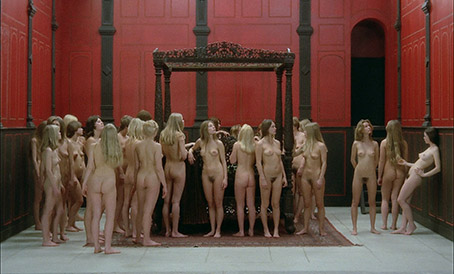
The film is made up of four stories of unequal length (it was originally five, but Borowczyk himself removed one – see the extra features for details) that are less about sex than moral corruption, although sex in some form or another figures in all four. In an interview on the Blanche Blu-ray, Borowczyk rejects the notion that his later work should be classified as erotic cinema, and expresses the conviction that such scenes in any film of quality were there because the story required them to be. To an extent this is certainly true of Immoral Tales. Where I find myself questioning this proclamation is the amount of screen time given over on each story either to the sexual act or to observing, often in lingering close-up, the bodies of the young ladies (not the men or the older women, it should be noted) who are required to strip for the camera. By the final story, I was able to predict the exact shot Borowczyk would use to observe the undressing of a young woman, with a close-up of her breasts that gradually drops down to groin level as the clothing is removed. Though always exquisitely executed, there is occasionally a sense that these sequences are underscored with just a whiff of "Wow, will you take a look at that!"
We live now in inescapably pornographic times, to the point where there seem to be precious few words that you can type into a search engine that will not include at least one nude or even hardcore picture in the results. Immoral Tales was made in a time before such unfettered access to such material had dulled our responses. And in spite of its adult content and an almost voyeuristic fascination with youthful female sexuality and form, I would reject the charge that this film is pornographic. Take another look at that definition at the top of the page. Now it's certainly possible that the images here will indeed provoke sexual excitement in some viewers. Back in 1974 I'd guarantee that they did. But to suggest that viewer titillation was Borowczyk's sole purpose here would be off the mark. There's more going on here than just ogling artistically at young naked females, and before the film is over it becomes clear that for Borowczyk these scenes are often a means to an end. I just wasn't always completely certain what that end was intended to be.
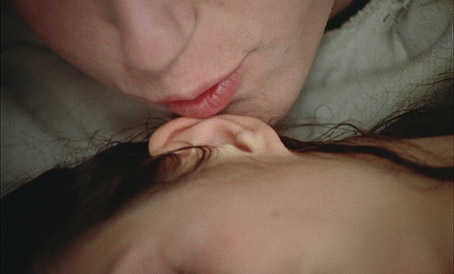
Take the first story, The Tide, which was based on a short story by surrealist writer André Pieyre de Mandiargues. 20-year-old André (an early role for Fabrice Luchini) takes his 16-year-old cousin Julie (Lise Danvers) to a point on a nearby beach where he knows that they will become trapped by the tide. Once they have been cornered by nature, he demands that she remove her bathing suit, then instructs her in the art of fellatio, which she performs on him while he recites facts about the workings of tidal waters. I'll admit that I had some trouble with this one. Visually seductive and making evocative use of the sound of the rhythmic rush of waves, it breaks with Borowczyk's previous perpendicular approach to framing and certainly meets the criteria set by the main title. There may well be deeper readings to be made here (but given its surrealist origins, possibly not), but on the surface the humourless André's actions qualify as sexual abuse – that Julie so willingly complies with his wishes did not ease my discomfort, particularly given the opening proclamation she was so readily susceptible to his authority. What is intriguing is that the tide itself becomes as much a character in the story as André and Julie – at one point the camera even appears to be watching the couple from the tide's point of view, and it seems to engulf them in a metaphorical ménage-a-trois at the moment of André's climax. Read into that what you will.
In the second story, Thérèse Philosophe [Therese Philosopher], young Thérèse H is admonished by her mother for not coming straight home after church and is locked in a room to contemplate the error of her ways. In the process of searching through the room's curious contents, she discovers a book littered with pornographic drawings, at which she is at first shocked and then aroused by, and which she ultimately responds to by masturbating with a cucumber. Well, two cucumbers actually, one of which she manages to chop into segments in the process. At the conclusion of this activity, she hops through the window and heads off towards her destiny.
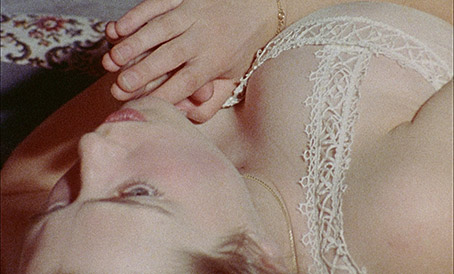
On the surface, this is a tale whose sole raison d'être is its centrepiece masturbation scene, and in that respect the 'erotic film' label certainly fits. That said, it's more recognisably the work of its director than The Tide, notably in how the images are framed and in the fact that he appears to be as interested in the objects in the room (cucumbers included) as Thérèse herself, something that would doubtless bemuse the dirty mac portion of its audience. But there's something else going on here, a Buñuelian mockery of religious sanctity that is quietly subversive. As the opening title card informs us, Thérèse was a pious young girl who was made a saint after being raped by a vagrant, and yet here Borowczyk has the girl in question embark on her own sexual adventure immediately before the fateful assault. And it's nothing so simple as a sneaky wank either – for Thérèse it's a genuinely religious experience, a misreading of her love for Christ that expresses itself through physical attraction and fantasised copulation. This alternate take on religious devotion is first hinted at in the opening scene, when she explores the sensuality and sometimes phallic nature of church paraphernalia (including the deep throb of organ pipes), and is openly proclaimed when she precedes her masturbatory adventures with the assurance, "I am coming to you, sweet Jesus."
But for me at least, it's in the third story, Erzsébet Báthory, where the film comes into its own. For those who know their dark history, Báthory's name will be a familiar one (albeit under her Anglicised first name of Elisabeth). A 16th century countess with the dubious honour of being history’s most prolific female serial killer, she's been accused of the torture and murder of literally hundreds of young girls. Legends grew up around her, the most famous being that she bathed in the blood of young virgins in the belief that it preserved her youth, a fable that became the basis for Hammer Films' 1971 Countess Dracula. Knowing this in advance gives the segment the aura of a slow-burn horror, as village girls are recruited by Báthory (played, incidentally, by Pablo Picasso's youngest daughter Paloma) and her young page, then taken to their castle and left to wash and prepare themselves for a fate that awaits them, the nature of which they have no inkling. The lingering, by this point trademark close-ups of breasts, buttocks and pubic hair are still there aplenty, but the deeply troubling concentration camp overtones are impossible to shake off, and the sequence in which the girls are driven to a state of near hysteria in an expressionistically red-walled room, as the period music collides with more sinister notes, feels uncannily like a trial run for Pasolini's 1975 Saló, or 120 Days of Sodom. And this sense of escalating dread has a visually startling payoff when Báthory bathes in the blood of the girls, an image that is darkly beautiful as it is horrific.
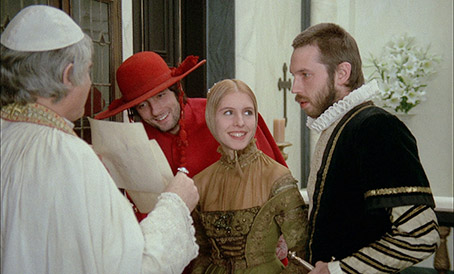
The final sequence, Lucrezia Borgia, is the most overt in its intentions, an open attack on the hypocrisy of those in positions of power within the Catholic Church. In 1498, Lucrecia Borgia pays a visit to her father, Pope Alexander VI, and her brother Cesare. She's accompanied by her effete and impotent husband, Giovanni Sforza, who's clearly new to the very special relationship the members of this infamous family have with each other. When Alexander delights his offspring with explicit drawings of a randy horse, Giovanni is deeply shocked, and shortly after is removed from the room by guards so that Lucrecia, Cesare and Alexander can sexually satisfy each other. Later the Pope gets to bless the child of this unholy union with all of the ludicrous pomp that the church can muster. Meanwhile, Dominican Hyeronimo Savonarola denounces the church hierarchy from a pulpit, and quickly finds himself arrested and burnt at the stake for his trouble.
Subtle its messaging may not be, but it's precision targeted and in filmmaking terms is handsomely realised, particularly Borowczyk's use of his favoured head-on framing and the gorgeous, ironically majestic music score. It also has a few enjoyably quirky elements – just about everything involving the Pope's treasured biscuits, which here are as much a symbol of temptation as the Garden of Eden apple, has a comically surreal and even symbolic edge, from the Bible shaped box in which the biscuits are stored to the devout Giovanni's silent and repeated reluctance to accept one.
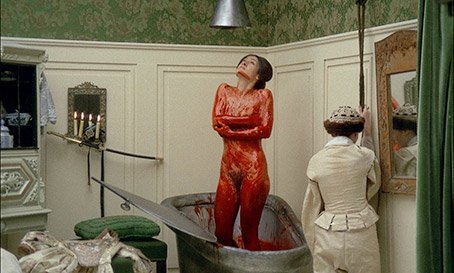
I'll freely admit that after three discs of genuinely revelatory cinema, Immoral Tales failed to ignight the same sort of fire for me, at least on the first viewing. It probably didn't help that the first story was the one that I responded to with the least enthusiasm, and it took a second viewing for the subtleties of the second tale to really hit home. It was with the third story that I started really to get a feel for what Borowczyk was up to, and second time around I was far better placed to appreciate the film's considerable virtues. That's not to say that I'm ready to put it on a par with Blanche or Goto Isle of Love, because I'm not. Yet despite having spent a disproportionate amount of the film's running time gazing at the bodies of attractive young females, I'm unwilling to simply label Immoral Tales an erotic film and be done with it. It is an erotic film, whatever its eloquent director may say, but it's not just about titillation, not by a long chalk, and a more exquisitely executed film of its type you'll be hard pushed to find. And no, that wasn't intended as a double entendre.
Presented in its original aspect ratio of 1.66:1, the film was transferred and restored from a 35mm Interpositive, and the Thérèse Philosophe sequence from a 35mm low contrast print made from the 16mm reversal original element. The picture was graded and restored in High Definition and the sound was remastered from the original magnetic reels. All work was carried out at Scanlab under the supervision of Isabelle Raindre of Argos Films.
Being shot on 16mm (each of the stories was effectively made as a separate short film), the image quality of Thérèse Philosophe is in some ways inferior to that of its shot-on-35mm brethren – the film grain is far more pronounced, the picture detail not as crisp and the colours more subdued, although I'm putting this partly down to the production design. That said, considering that this was likely shot on high speed stock (an educated guess based on the level of grain), this is still a strong transfer – the picture elements are clearly rendered, and there's a very real intimacy created by this particular aesthetic that actually works rather well for the story. But move on to the 35mm-shot sequences and the richness of the image and the scalpel-sharp level of detail are sometimes breathtaking. The shoreline landscapes of The Tide have a gorgeous, painterly quality, and the eye-popping sharpness of the daylight exteriors when Báthory rides into the village in search of young girls is one I'll be using to show off the virtues of Blu-ray, at least to my less prudish visitors. The colour rendition in the Báthory castle interiors is also striking, not least the deep red of the blood in which the Countess bathes. Ever the perfectionist, Borowczyk insisted that real blood be used when the ersatz substitutes just didn't have the right colour and feel.
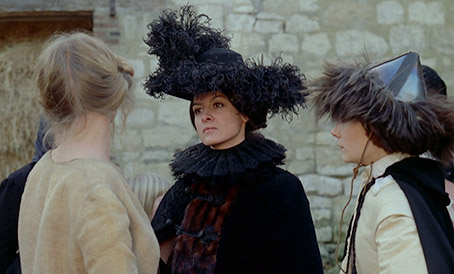
The Linear PCM mono 1.0 sound (mono 2.0 on my system – still can't work that one out) has a slight treble bias and little in the way of strong bass response, but the clarity is excellent, with the music in particular sounding terrific throughout. There is no trace of background hiss or hum and no evidence of damage.
Introduction by Borowczyk expert Daniel Bird (5:14)
Instead of the interview you'll find on the other discs in Arrow's Borowczyk collection, this is effectively a trailer for the film comprised of extracts interspersed with informative captions. These provide details of the film's controversial London Film Festival screening (more on that below) and its popularity within the genre (the second-most popular erotic film of 1974 after Emmanuel), and gives a small taste of what to expect.
Immoral Tales: L'Age D'Or Cut (1974) (125:25)
Immoral Tales was originally screened at the London Film Festival in an incomplete form. Two short films were scheduled – the prelude to the main feature, A Private Collection and The True Story of the Beast of Gévaudan – with the hope that they would be joined by a third (The Tide). The screening sent audience members scurrying for the lobby and outraged the critics, but the film was nonetheless awarded the Prix de l'Age d'Or, which was presented annually to a work of fiction 'whose invention and cinematic qualities testify to the spirit of freedom and subversion comparable in our time, to that of Buñuel in 1930.' Borowczyk eventually cut The Beast from the finished feature to reduce the running time, and a year later expanded it into a feature. The version of the film here includes this sequence. So what, you might wonder, was it about this particular tale that caused such a scandal?
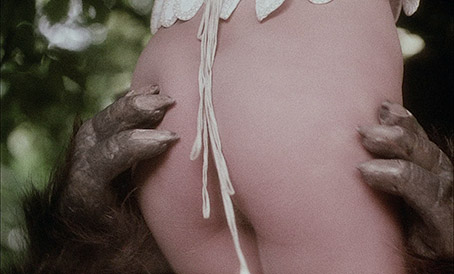
Well if you're looking for confirmation of the second part of that quote about Borowczyk at the top of this review then your search is over. There's undoubtedly a deliberately and determinedly subversive element to what was described in the London Film Festival programme as "a retelling of Beauty and the Beast with emphasis on their sexual relationship," but this segment is about sex and sex alone. And we're not the consensual kind between young lovers, the sort that would justify the use of the term 'relationship'. At least not at first. If you had trouble with the rape scene from Straw Dogs (and we all did to a degree, didn't we?), then try this on for size. In 1765, the Mistress of a country estate notices that one of her lambs has disappeared and wanders into the woods to find it. Instead she encounters its carcass and the notorious Beast of Gévandau, who chases her through the trees sporting a serious hard-on, and in what plays almost like a porn film parody, the young lady's clothing is ripped from her body, piece by piece by the creature and just about every tree branch she passes. As the Beast chases after her, the camera focuses on her fleeing buttocks, with occasional cut-aways to her half-naked breasts. When it catches her, the Beast proceeds to sexually assault and then rape her. Terrified at first, she starts to enjoy it, and in the encounter that follows has semen sprayed on her back and chest (which she enthusiastically spreads over her breasts), before giving the creature a foot-job and gleefully rubbing her face in the emissions from his ever-ejaculating penis. Frankly, I was gobsmacked. Fuck knows what the 1974 London Film Festival made of it. Even today, this would qualify as extreme cinema, and there's very much the sense that Borowczyk was deliberately playing the provocateur here in an attempt to see how far he could push his luck. I can't wait to see what he did with the feature version.
Love Reveals Itself: Making Immoral Tales (16:42)
A shorter than usual look back at the making of the film, built around interviews with Dominique Duvergé, Borowczyk's assistant on the film (who is heard but never seen here) and Noël Véry, who was promoted from camera assistant to cameraman on the film when shooting went over schedule and Guy Durban had other work commitments. Apparently Durban was not too happy with this, and Véry amusingly recalls Borowczyk's advice to him to keep his mouth shut and assurance that he would explain to Durban why he wanted a new cameraman. "So I kept my mouth shut." says Véry. "But Boro kept his mouth shut as well. Bastard!" There are a couple of interesting revelations – Isabel Adjani was up for but turned down the role of Julie in The Tide, and I was amazed to discover that some of the exterior close-ups in the episode were shot later in a hotel room and just lit accordingly. Wow. Véry even shows us the rig that he used to steadily film hand-held, which is similar to the ones in common use today. It was designed and built by Borowczyk, of course.
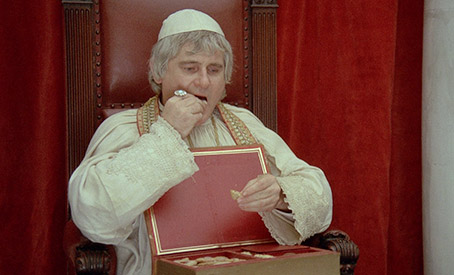
Boro Bunch: Crew Reunion (7:37)
On 9 Feb 2014, Noël Véry reunited a number of people who knew and worked with Borowczyk for a dinner and a chat about their memories of the director and working on his films. Those attending include: Dominique Duvergé; director Florence Dauman, daughter of Immoral Tales producer Anatole Dauman; Philippe d'Argiula, who was married to Borowczyk's regular costume designer Piet Bolscher; Zoe Zurstrassen continuity supervisor on Borowczyk's 1983 The Art of Love ("I loathe that film," Duvergé reveals); and Dominique Rivolier-Ruspoli. I was left with the sensation that this was a sample of a longer piece, but it's still enjoyable, and quite of bit of ground is covered in the brief running time, though not enough for me to start listing examples here (there'll be nothing to surprise you otherwise).
A Private Collection (1973) (12:12)
Intended as a prelude to Immoral Tales, this is effectively a guided tour of Borowczyk's personal collection of erotic memorabilia, which ranges from paintings to antique pornographic photos, a hardcore cartoon slide show and, best of all, a selection of hand-made mechanical amusements. Narrated by surrealist writer André Pieyre de Mandiargues, whose story The Tide was the foundation for the first segment of the main feature, it also nicely highlights how reaction to explicit imagery depends on the medium of its delivery – while the hide-nothing paintings are uncensored, the potentially offending portions of the photographs are concealed with a strategically placed finger. Which brings us nicely to...
A Private Collection – The Oberhausen Cut (1973) (14:31)
A longer, alternative cut of the above, this time without those carefully placed fingers and with the addition of a sequence of looped animations that are intercut with film footage of a woman having sex with a dog. For real. I know this because I read about it in the booklet – as this would contravene British obscenity law, the offending shots have all been blacked out, but there's just enough left at each end of the sequence to give you an idea what you didn't see.
Theatrical Trailer (2:20)
A distinctly odd trailer made up exclusively of shots from a single sequence from Erzsébet Báthory and containing an awful lot of shots of naked women.
Booklet
Yet another fine literary companion to the film, the 28-page booklet includes the following: a typically learned essay on the film by Daniel Bird, amusingly entitled A Plate Full of Cucumbers; a selection of extracts from contemporary reviews, including two hostile responses to that LFF screening; a smart review of the film by Philip Strick from the Summer 1977 edition of Sight & Sound; a short but informative piece on A Private Collection by Michael Brooke; details of the restoration and credits for the film.
It's funny how a second viewing of some films can clarify things that pass you by on the first. Such was certainly the case with Immoral Tales, which I warmed to far more the second time around, though I'm still not sold on the virtues of The Tide, other than its lovely cinematography. But despite the film's obsession with young female flesh, it's still too exquisitely made, too smartly devised and too peppered with intriguing detail and subtext to be dismissed as high class pornography (softcore for the most part, something else entirely for The Beast). As for the disc, well the restoration and transfer are nothing short of superb, and the extra features excellent. For the non-prudish at least, and particularly for Borowczyk enthusiasts old and new, the disc comes highly recommended.
|